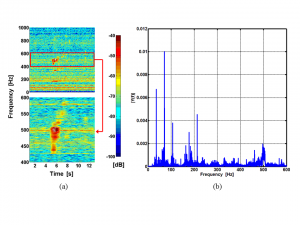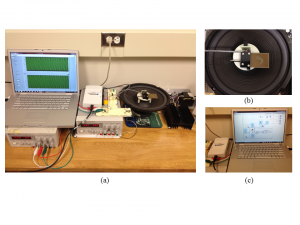Harvesting Energy from Non-ideal Vibrations
- Category: Circuits & Systems
- Tags: jeffrey lang, samuel chang
This project focuses on two vibration non-idealities that affect the performance of vibration energy harvesters [1] [2] . Most vibration energy-harvesting research focuses on harvesting from a fixed-frequency single-harmonic vibration. Correspondingly, most harvesters exhibit a single mechanical resonance that couples to the vibration. Real vibration spectra, however, often exhibit multiple and/or non-stationary harmonics and random background vibrations. The inability to handle such non-ideal vibration sources has become a technological obstacle to the applicability of vibration energy harvesters. This work addresses the two major non-ideal vibration conditions illustrated in Figure 1: the non-stationary behavior of individual vibration harmonics, i.e., the slow drift of their frequencies over time; and the multi-harmonic character of the vibration spectra. It does so both theoretically and experimentally by modifying the behavior of a single-resonance vibration energy harvester through its electrical load [3] .
To support the experimental work, a vibration harvesting test bench is developed. The test bench is built around the V25W piezoelectric (PZT) energy harvester manufactured by Mide Technology. Figure 2 (a) shows the complete test bench; Figure 2 (b) shows the V25W PZT harvester mounted on a shaker table; and Figure 2 (c) shows the computer-based control and measurement system through which the test bed is excited and observed. It should be noted that the work pursued here uses a piezoelectric harvester out of convenience. The modifications studied here are applicable to vibration energy harvesters employing other energy conversion physics such as electric- and magnetic-based conversion.
- Figure 1: Non-ideal vibrations recorded from an office window. (a) Vibration frequency changes with time. (b) The multi-frequency (multi-harmonic) nature of the vibration.
- Figure 2: (a) Experiment setup of the entire system. (b) Piezoelectric harvester mounted on a shaker table and ready to be tested. (c) LabView and the USB-6211 control box by National Instruments enables multiple analog input and outputs.
- S. Roundy, P. K. Wright, and J. Rabaey, “A study of low level vibrations as a power source for wireless sensor nodes,” Computer Communications, vol. 26, no. 11, pp. 1131-1144, 2003. [↩]
- C. B. Williams and R. B. Yates, “Analysis of a micro-electric generator for microsystems,” Sens. Actuators A, Phys., vol. 52, no. 1-3, pp. 8-11, 1996. [↩]
- V. R. Challa, M. G. Prasad, Y. Shi, and F. T. Fisher, “A vibration energy harvesting device with bidirectional resonance frequency tunability,” Smart Mater. Struct., vol. 17, no. 1, p. 015035, 2008. [↩]

